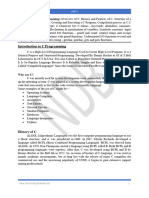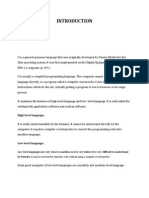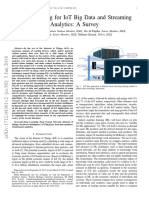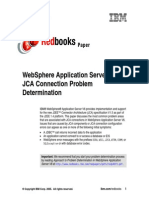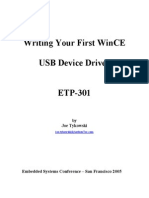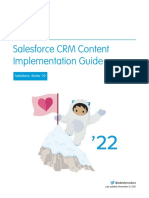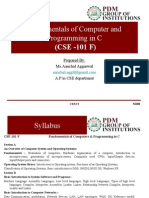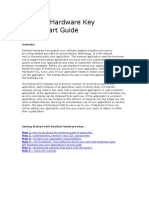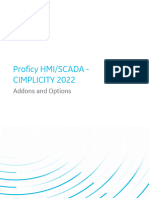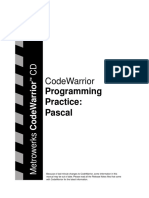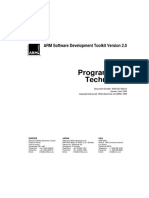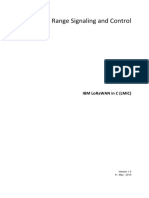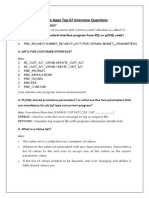Thapathali Campus Introduction to C
Bibha Sthapit
INTRODUCTION TO C
1. History of C
An ancestor of C is BCPL Basic Combined Programming Language. Ken Thompson, a
Bell Laboratory scientist, developed a version of BCPL, which he called B. Dennis
Ritchie, another computer scientist, developed a version called C in early 1970s that is
modified and improved BCPL. Ritchie originally wrote the language for programming
under UNIX operating system. Later Bell Laboratories rewrote UNIX entirely in C.
In C, I/O support is provided in the form of library of the object code that can be linked
with the users program. In the 1970s and 1980s, many organizations wrote and
implemented C compilers, which differed from one another in their requirements and
libraries. One type of machine might even have several different compilers. To establish
uniformity and facilitate portability, in 1989 ANSI (American National Standards
Institute) approved standards for the language as well as the required libraries. For e.g.,
ANSI specifies the standard I/O library, including stdio.h.
2. Characteristics of C
We briefly list some of C's characteristics that define the language and also have lead to
its popularity as a programming language. We will be studying many of these aspects
throughout the course.
Portability
One of the reasons of Cs popularity is its portability. We can easily transform a
program written in C from one computer to another with few or no changes and
compile with appropriate compilers.
Faster and efficient
C is desirable because it is faster and more efficient than comparable programs in
most other high level languages. For e.g., a program to increment a variable from 0 to
15000 takes about 50 seconds in BASIC while it takes 1 second in C.
Supports structured programming
It is well suited for structured programming, that means, the problem might be solved
in terms of function modules or blocks. The modular structure makes program
debugging, testing and maintenance easier.
Extendibility
Another property is extendibility. C is basically a collection of functions that are
supported by C library. We can continuously add our own functions to C library.
Flexible
C is a flexible language. It permits us to write any complex programs with the help of
its rich set of in-built functions and operators. In addition, it permits the use of low-
level language. Hence it is also called middle-level language and therefore it is well
suited for both system software and business package.
- 1 -
Thapathali Campus Introduction to C
Bibha Sthapit
3. Basic structure of C programs
C is a group of building blocks called functions, which is subroutine that may include one
or more statements designed to perform a specific task.
Documentation section consists set of comment lines giving the name of program,
author, and other details to be used later by programmer. The compiler ignores any
comment so they do not add to the file size during the time of execution. Comment lines
which starts with // for single line comment OR /*.*/ for multiple line comment.
Link section provides instruction to compiler to link functions from system library.
Definition section defines all symbolic constants.
Global declaration section declares all variables used in executable part globally.
Main function section is a must section and one program contains only one main. Main
function section starts with opening brace { and ends with closing brace }. It consists
declaration and execution section. Declaration part declares all variables used in
executable part. There must be at least one statement in executable part. Each statement
ends with semicolon except for function definitions, control statements and loops.
Subprogram section contains all user-defined functions that are called in main()
function.
Documentation section
Link section
Definition section
Global declaration section
Main() function section
{
Declaration part
Execution part
}
Subprogram section
Function 1
Function 2
Every C program consists of one or more modules called functions. One- of the functions
must be called main () .The program will always begin by executing the main() function,
which may access other functions. Any other function definitions must be defined
separately, either ahead of or after main ().
The main () function can be located somewhere in the program so that the computer can
determine where to start the execution. This function can be allocated anywhere in the
program but the general practice is to place it as the first function for better readability
Any function in C program consists of valid C statements and is linked together through
function calls. A function is analogous to the subroutine or a procedure in other higher-
level languages. Every function in a program has a unique name and is designed to
- 2 -
Thapathali Campus Introduction to C
Bibha Sthapit
perform a specific task. Each function is defined by of a block of statements, which are
enclosed within a par and is treated as one single unit.
Every instruction in C program is written as a separate statement. These statements must
appear in the same order in which we wish them to be executed; unless logic of the
problem demands a deliberate jump or transfer of control to a statement, which is out of
sequence.
Rules for statements:
Generally all C statements are entered in small cases letters.
Any C statement always ends with a semicolon (;).
C has no specific rules about the position at which different parts of a statement
are to be written.
Example:-
#include <stdio.h> //header files
#include <conio.h>
void main() //main function
{
clrscr(); // library functiion to Clear the screen
printf(This is first lecture in C programming);// library function that prints the
given string
getch();
}
4. Steps to execution
Source Preprocessed Object Executable
code source code code code
Linker Editor Preprocessor Compiler
External items
Editor: It is a specialized word processor to create and edit source code and data.
Source code is a program typed into the computer. You write a computer program
with words and symbols that are understandable to human beings. This is the editing
part of the development cycle. You type the program directly into a window on the
screen and save the resulting text as a separate file. This is often referred to as the
source. The custom is that the text of a C program is stored in a file with the
extension .c for C programming language.
Preprocessor: It is a program that removes all comments and modifies source code
according to directives supplied in the program. A preprocessor directive begins with
# and it is an instruction to the program. For e.g., #include<stdio.h> instruct the
preprocessor to replace the directive with the contents of the file stdio.h.
Compiler: You cannot directly execute the source file. To run on any computer
system, the source file must be translated into binary numbers understandable to the
computer's Central Processing Unit. Compiler translates the preprocessed source code
- 3 -
Thapathali Campus Introduction to C
Bibha Sthapit
into machine language that consists sequences of 0s and 1s. If the compiler finds any
error, the compilation may continue in order to detect further error but computer
wont produce any compiled program. If compiler doesnt detect any error, then it
produces object code, which is machine language version of source code. This
process produces an intermediate object file - with the extension .obj. The .obj stands
for Object.
Linker: It combines all the object code of a program with necessary items (i.e.,
library files) to form an executable program. Often a program is so large that it is
convenient to break it down into smaller units, with each part stored in a separate file.
Many compiled languages come with library routines that can be added to your
program. Theses routines are written by the manufacturer of the compiler to perform
a variety of tasks, from input/output to complicated mathematical functions. In the
case of C the standard input and output functions are contained in a library (stdio.h)
so even the most basic program will require a library function. Moreover our program
might use features like printf that are defined elsewhere, perhaps in a C library.
After compilation of our program files, the computer must somehow link these
separate pieces to form a single executable program. This linking is done by linker.
After linking the file extension is .exe which are executable files.
Executable files: Thus the text editor produces .c source files, which go to the
compiler, which produces .obj object files, which go to the linker, which produces
.exe executable file. You can then run .exe files as you can other applications, simply
by typing their names at the DOS prompt or run using windows menu.
5. Procedure oriented programming (POP) language
It is a collection of number of instructions where each instruction tells computer to do
something. In the procedural oriented approach, the problem is viewed as sequence of
things to be done such as reading, calculating and printing. To fulfill these tasks, number
of instructions is written and program is organized into different groups known as
functions. So, in this approach, attention is given to the procedure to solve the problem. A
very little attention is given to the data that are used by different functions.
Important features of POP:
1. Emphasis given to procedure
2. Programs are divided into different functions
3. Data have very low security
4. Top down approach is used in programs
- 4 -




